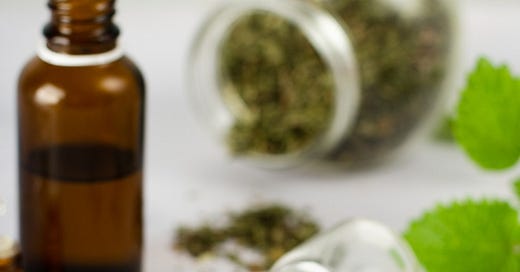Herbs and food for lower back pain
I threw out my back on Thanksgiving, which prompted me to research foods that could help support and accelerate my recovery.
We celebrated Thanksgiving the week before the official holiday, so on Thanksgiving I had a slow morning starting the DIY facelift of our primary bathroom. I painted the cabinets and started painting around the trim on the walls. Around lunchtime, I moved outside to take advantage of the great weather. Our back patio has served as a pseudo-barn-slash-potting shed and I wanted to get it cleaned up and bring it back to life as a patio. I moved everything out into keep, donate, and trash piles, and I also started setting up a dedicated potting space around the corner under the back deck. The freshly-swept patio looked just as it had years ago when we moved in. I got hopeful about getting some furniture to use it more.
Just as I bent down to pick up the last fence post to move it to storage, an awful pain shot through my left-lower back and I couldn’t stand up. I had our puppy tethered to the house while the chickens free-ranged around us. My husband was in his shop at the time. I hobbled to the puppy, unclipped him, and got him in the back door. I held on to the doorframe and slowly raised myself to standing. I’m not sure how I managed, but I somehow got all the chickens secured in the coop.
I attempted to rest on the couch, but sitting was uncomfortable. So was standing. So was laying down. I started Googling.
Rest, ice, and elevation weren’t all possible. I couldn’t find a comfortable position to rest. An icepack, which normally would be too cold on a sprain or a sting (I find ice helps a lot with bee stings) to hold on the skin directly without a towel barrier, wasn’t cold enough for my back. I kept it directly on my back for an hour at a time for days. My back was so inflamed I hardly felt the cold. Elevating my lower back didn’t seem possible.
Among my internet searches I wanted to learn what I could lean on from my pantry and garden. Some foods weren’t a surprise at all, but some were. Here’s what I found:
Turmeric. This didn’t surprise me. The first thing I think of when I see turmeric is anti-inflammatory. Fortunately, I had a huge bag of turmeric from Mountain Rose Herbs leftover from a gift tea blend I had made. Whenever you cook or brew turmeric, add black pepper to help increase its absorption. Black pepper increases the bioavailability of turmeric nutrients by 2,000 percent.
Valerian root. I always think of valerian root as a calming herb, so I was happy to see it come up in my research. I also had a lot of this from my Mountain Rose Herbs order.
Ginger. Always a gem for inducing calmness and reducing inflammation!
Holy basil. One of my favorite adaptogenic herbs. I had planned on putting some into my tea anyway since it gives you whatever you need. See my earlier post about plants that feed me and the bees.
Lavender. Another great anti-anxiety and anti-inflammatory.
ACV and honey. I was thrilled to see these ingredients! ACV helps to reduce excess acid in our bodies. ACV also has magnesium and potassium, and both are known to reduce joint pain. Honey’s many beneficial properties combine to help reduce back pain. A common health drink: a tablespoon of ACV with a tablespoon of honey mixed in a glass of water.
Ashwagandha tincture. This isn’t something I imagine most people have in their pantry, but I happened to have this from a few years ago when I was stocking up on herbal support for stress management. In addition to stress relief and pain management, it also helps with sleep. I knew I needed good sleep to help heal.
Bone broth. We have a ton of bone broth in the freezer and I make a batch weekly. I use it for cooking rice, adding to our pup’s meals, making sauces, and just to sip on its own. NOURISHING TRADITIONS, a book I recently started reading, goes into great detail about the many uses and benefits of bone broth.
Steamed potatoes. We’re still working through the “root cellar” (a metal cabinet in the basement with potatoes and sweet potatoes). I love steaming potatoes and tossing them with salt and garlic. And fortunately…
Garlic. Another great (and common) anti-inflammatory. Fortunately, I still have several heads of garlic from this year’s garden harvest and I’m now adding double to our meals.
Broccoli. The vitamin K in broccoli is known to help reduce back pain. I was late to get my fall seedling in, so all of my broccoli plants are just babies right now. I’ve been stocking up on frozen broccoli in between fresh broccoli from the farmers’ market.
Pumpkin. Both the seeds and the pumpkin flesh can help support spinal pain. High values of magnesium and beta carotene are to thank for that. Fortunately, I have plenty of pumpkins from this year’s harvest.
Blueberries. This surprised me. I didn’t realize the flavonoids in blueberries help to reduce back pain.
Cacao. With a significant amount of magnesium, cacao can help support back pain. I take a magnesium supplement twice per week, but I increased it to three times per week while I heal.
Banana. The punch of potassium helps improve nerves while at the same time reducing overall inflammation.
Combinations of these ingredients:
Smoothies. One of my favorite breakfasts, afternoon snacks, or desserts is either a smoothie bowl or a smoothie of peanut butter, blueberries, banana, and cacao. If I don’t have milk available, it’s a bowl. I was relieved to see almost all of those ingredients come up in my food search to heal my back. I skipped peanut butter during the most painful times.
Golden milk. While conventional dairy generally has inflammatory properties, either raw milk or a nut milk could be swapped as a base. Add in some turmeric, black pepper, and honey, then warm it up for a soothing bev.
Honey-garlic broccoli. I’ve been loving this as an extra side dish. I flash-boil broccoli in bone broth, then toss it with raw garlic, honey, and salt.
I had never thrown out my back before, so I was anxious to know when (and at times—if!) I’d be well. During those first few days I had even talked with my husband about selling my beehives because I couldn’t fathom managing them with the pain I was experiencing.
It’s taken nearly a month to feel close to normal, and I’m not there yet. I combined these herbs and foods with daily yoga and stretching, walks, a back support band, and sleeping on my back with a pillow under my legs. All of these efforts combined have helped tremendously. I’m also getting acupuncture for the first time and meeting with doctors over the next few weeks. I’m hopeful I’ll be back to normal in time for swarm season for the bees. I’m hopeful I’ll be back to normal in time for swarm season for the bees.





